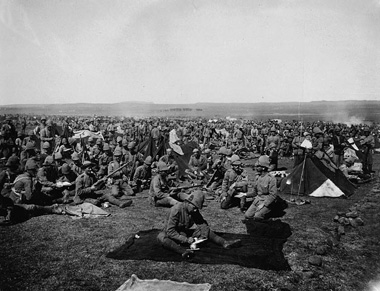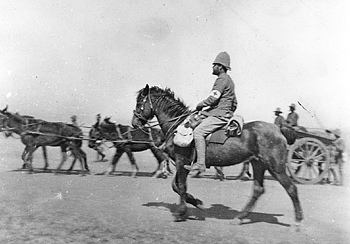Battles
Israel's Poort
25 April 1900

The 2 RCRI on Bloemfontein Common, South Africa, 1899-1901, NAC 003477
On 21 April 1900, 27 officers and 584 men of the 2nd (Special Service) Battalion, Royal Canadian Regiment of Infantry, left the Orange Free State capital of Bloemfontein, where they had endured a devastating epidemic of enteric fever. They marched eastwards as part of a British offensive to cut off Boer forces operating to the south-east.
The route from Bloemfontein followed a long valley which progressively narrowed until the road was commanded by a line of kopjes (small hills) at Israel's Poort. The Boers held this position in strength, lining both the left (northerly) wall of the valley, and the kopjes plugging the bottleneck at the valley's end. The British force arrived at this position on 25 April.
The British commander decided to outflank the Boers with his mounted infantry, rather than undertake a deliberate frontal attack. However, as a prelude to this manoeuvre, he used his infantry to hold the Boers in place. The Canadians were the lead battalion. Advancing under heavy fire, they reached a wire fence 800 metres from a kopje. Lieutenant-Colonel W.D. Otter, the Canadian commanding officer, decided to pull the men back a short distance into the cover of a ravine. The situation became confused and some of the troops began to waver. The officers and non-commissioned officers restored order and the manoeuvre was completed successfully. In the process, Colonel Otter was struck by two bullets: one clipped his badge of rank from his left shoulder strap, while the second grazed his chin and then hit his neck, causing a flesh wound.
In the meantime, the British flanking movements began to lever the Boers out of their strong position. With resistance lessening, two Canadian companies advanced up a narrow ravine running obliquely across the field, and suddenly appeared to the rear of the Boers. This settled the matter, and the Boers abandoned the position. Casualties were remarkably light considering the length of time the men had been under fire. One man was killed, and three wounded, including Otter, who would be out of action for a month. Israel's Poort, the first major engagement for the Canadians since Paardeberg, firmly established the Royal Canadians as a veteran battalion.
 Mounted medical orderly and regimental
transport of 2
RCRI on
the move.
Mounted medical orderly and regimental
transport of 2
RCRI on
the move.